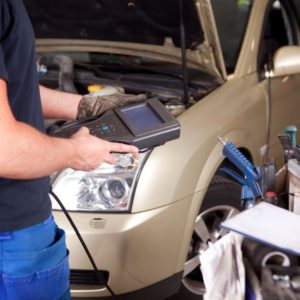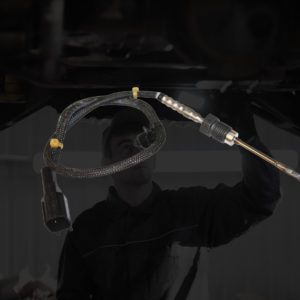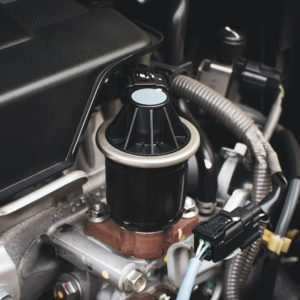To start with, you need to make sure that what’s coming out of your exhaust is gasoline rather than normal water vapor from a cool engine on a cool day because the engine makes water as it burns fuel.
Gas, particularly liquid gas or gasoline steam, from your exhaust pipe is a serious problem.
If you’re worried your vehicle has a gas leak, be sure to familiarize yourself with some of the potential causes:
- Damaged (open) fuel injectors due to wiring issues, a PCM driver, or a mechanically faulty injector with a bad fuel leak.
- Incomplete combustion in the cylinder because of far too much fuel.
- A ruptured fuel pressure regulator diaphragm (can cause hydrolock leading to serious engine damage).
Correctly Identifying Gas Leaks in the Exhaust
More often than not, the primary cause of fuel coming out of your exhaust is a gas leak into the cylinders from one or more injectors or a faulty fuel pressure regulator.

It’s important to know if you’re dealing with a gas leak or another issue like a wet exhaust because the consequences for these two problems are completely different.
Here are two ways to help you correctly identify gas leaks in your vehicle’s exhaust.
Check the Color of the Smoke
The first way to determine if it’s fuel that’s leaking from your exhaust is to look at the color of the smoke.
- Black smoke means a rich mixture but this will be soot rather than liquid gasoline and won’t typically produce a gasoline odor.
- Blue smoke is oil and this can be from engine oil consumption issues.
- White smoke on a hot engine and coolant dripping from the exhaust will typically be steam from a failed head gasket allowing a large amount of coolant to enter the cylinder.
- White smoke on a cold engine on a cold day is normal. There’s even a small hole in the bottom on the end of the muffler on most cars to allow this water to drain out.
Gasoline leaving the exhaust as liquid or steam can only be the result of large amounts of fuel entering the intake or combustion chambers via injectors.
Take care not to inhale too much because the fumes from your vehicle’s exhaust are toxic.
Gasoline leaving the exhaust as liquid or steam can only be the result of large amounts of fuel entering the intake or combustion chambers via injectors.
–Richard McCuistian, ASE Certified Master Automobile Technician
Wipe the Leak With a Cloth
The second way to check if you have a gas leak is to catch some of the fluid at the tail pipe with a cloth. This way works best if you don’t want to risk breathing in fumes from the exhaust. Bear in mind that this method requires a disposable cloth which you’ll use to absorb some of the leaking liquid.
Once the fluid is absorbed, bring your soaked cloth someplace far from your vehicle. Once there’s some distance between the cloth and the vehicle, try setting the cloth on fire. If it is set ablaze, you might have a gas leak on your hands. If your cloth is soaked and doesn’t catch fire, it might just be water.

What Happens if Gas Comes Out of My Exhaust?
At some point, you might’ve asked yourself: “Is it safe to drive with a gas leak?”
To put it simply, the answer is no. Still, it’s worth knowing why it’s unsafe to drive vehicles with leaky exhausts. After all, this issue has the potential to spiral out of control, leading to even larger issues. Uncommanded fuel into the combustion chambers (either from the intake via a busted fuel pressure regulator diaphragm or injector issues) will contaminate the engine oil with fuel, leading to accelerated engine wear.
If there is fuel coming out of your exhaust, your vehicle might display a variety of long-term and short-term problems:
- Your vehicle is more at risk of vehicle fires.
- Your vehicle might have a rough idling engine.
- Your vehicle will reek of gas.
- Your vehicle will run out of fuel at a much quicker rate.
Risks of Unburned Fuel
Any fuel that leaks from your vehicle’s exhaust system tends to linger. The unburned fuel in the exhaust can potentially lead to problems like backfiring. That being said, backfiring is very rare now. It was more of a problem on carbureted engines than on fuel injected platforms. Induction backfire happens when combustion occurs in the intake manifold and is much more common, but this is an ignition or valve timing issue rather than a fuel issue.
- Catalytic converter damage: Uncommanded fueling can overheat the catalytic converter and often does.
- Power loss: Anything that causes the air-fuel mixture to be badly out of balance can cause power loss, and over-fueling is no exception.
Decreased fuel efficiency: If you have soot, gasoline steam, or liquid gas coming out your tailpipe, your fuel economy will suffer.
Any information provided on this Website is for informational purposes only and is not intended to replace consultation with a professional mechanic. The accuracy and timeliness of the information may change from the time of publication.

































